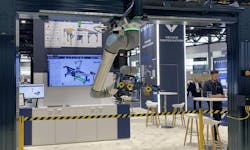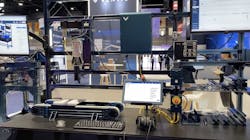A common theme in automation today is interoperability and openness. For many small to medium-sized manufacturers however, achieving this level of interoperability requires time and resources that many of these companies simply don’t have. And that doesn’t include the resources required to design an automated work cell, figure out what automation components are needed, which ones will work together and verify it all.
As a result, many smaller manufacturers have not automated to a great degree. This can be a detriment for these manufacturers as they work to fulfill customer demands and maintain—or obtain—a foothold as a key supplier.
At Automate 2024, I had the opportunity to meet with Etienne Lacroix, founder and CEO of Vention, an automation hardware and software platform provider formed in 2016 to address automation issues for small to mid-sized manufacturers. While Vention targets smaller manufacturers with its end-to-end automation platform, the company also highlights its ease of automating to larger manufacturers as well who face their own automation challenges amid re-shoring initiatives and skilled industrial labor shortages.
Explaining Vention’s approach, Lacroix said, “Traditional automation components are very good, but they're very complex to integrate. That's why manufacturers often need a system integrator, which can double the total cost of an automated system. And if you're producing, say, only 10,000 widgets a year, it will be difficult to achieve a return on that investment in a reasonable timeframe. Our strategy to solve this is platforming.”
Vention’s cloud-based platform as a service spans four areas:
- Design—includes MachineScope for defining project requirements and MachineBuilder for designing your machine or automated workcell.
- Automate—includes MachineLogic for programming without coding or using Python and MachineApps, a series of pre-configured software for common applications.
- Order and Deploy—includes MachinePortal for tracking orders and collaboration with Vention as well as MachineCloud for remote deployment.
- Operate—includes MachineAnalytics for remote monitoring, RemoteView for remote access to machines or workstations and RemoteSupport for on-demand support during and after deployment.
In addition to these automation software components, Vention also supplies the hardware needed, including structural and framing components, fixtures and tooling, panels and tabletops, robots, robot mounting, robot end of arm tools, safety devices, wheels, linear and rotary motion components, pneumatics, motors, control devices, vision systems, material handling, sensors, cabling and cable management.
From design to deployment
For users of Vention’s platform, Lacroix said the first step is active designing. “Users go online with Vention and design their system with a library of Lego-like parts,” he said. “If a part shows it is available for the assembly being designed, it is compatible. And as you design with those parts, it updates the assembly in real time—automatically populating the bill of materials as well as information about when it will ship. This simplifies the act of design tremendously, even for someone who’s not an expert at automated system design.”
After the design step, the next step is automating the environment that’s been created. “The typical divide between PLCs and robot programming does not exist in Vention because they’re one and the same,” said Lacroix. “Users program a robot and all the other devices—such as linear actuators, infeed conveyors, pneumatic systems and conveying systems—in this same environment. This is all done in our MachineLogic where users also create the HMI.”
In the deploy stage, users take all the programming they’ve done and download it to the workcell or machine hardware. Lacroix noted that, with the cloud-based digital twin used by Vention in the design stage, “everything will operate in the real world the same way as it did in the cloud, with the same run time, same motion planning, etc. It will all translate one to one.”
Hardware insights
While some hardware offered by Vention is supplied by other automation vendors, such as Keyence sensors and Datalogic light curtains, much of the hardware and software is from Vention.
“MachineMotion is our controller,” said Lacroix. “That's how we talk to all the other devices in a robot cell, whether it's an actuator, a safety system or sensors. The reason we care so much about this is that, if you don't have a centralized controller, the amount of the deployment tasks needed is through the roof. For example, try to wire bi-directional safety between a cobot and external axes. You’ll need two weeks just to do that [without pre-configured components]. With Vention, it’s going to be a simple cable between the two devices and all the logic is taken care of.”
Lacroix explained this aspect of Vention’s approach is crucial to small and medium-sized manufacturers. “If you want to serve these businesses very well, you need to get to plug-and-play. The concept of pick your own wires and terminal blocks does not exist at Vention. That’s why we decided to embark on an automation democratization journey that addresses both hardware and software.”
Cloud-based platform strategy
Providing more background on Vention’s strategy with its platform approach, Lacroix explained that “the only way for most manufacturers to automate has been to buy the hardware, assemble it and test it to see if it works. And, though most the time it does work, 30-40% of time it doesn't work the first time and then it's very painful. That's why having a very good digital twin helps, because you can figure out all the process issues ahead of time. So now, with one tool, you can go from ideation to design to simulation for de-risking to a one-click deployment from the cloud to the shop floor with full tracking and visibility of your equipment. So now you have this ecosystem of hardware and software, all intended to work together as one. And because everything is plug-and-play, there's no more technology risk, no more integration risk. The only thing left is the process risk and the software validates that in the cloud before deployment to minimize that risk.”
With its cloud-based design origins, Vention can provide extensive remote support given its detailed access to information about the systems its users design.
“If you're an operator in a small shop, you may need remote support to resolve an issue,” said Lacroix. “When you connect to Vention’s remote support via the HMI, the remote support can see your users, the machine and have access to your digital twin as well as your code. These details are all in the cloud, but once deployed it runs on the machine and you can disconnect it from the internet if you don't want that level of direct connection to your shop floor. But the design details are still accessible for support when needed.”
In the video below, Vention’s Carl Hajal walks us through several aspects of the Vention platform.




